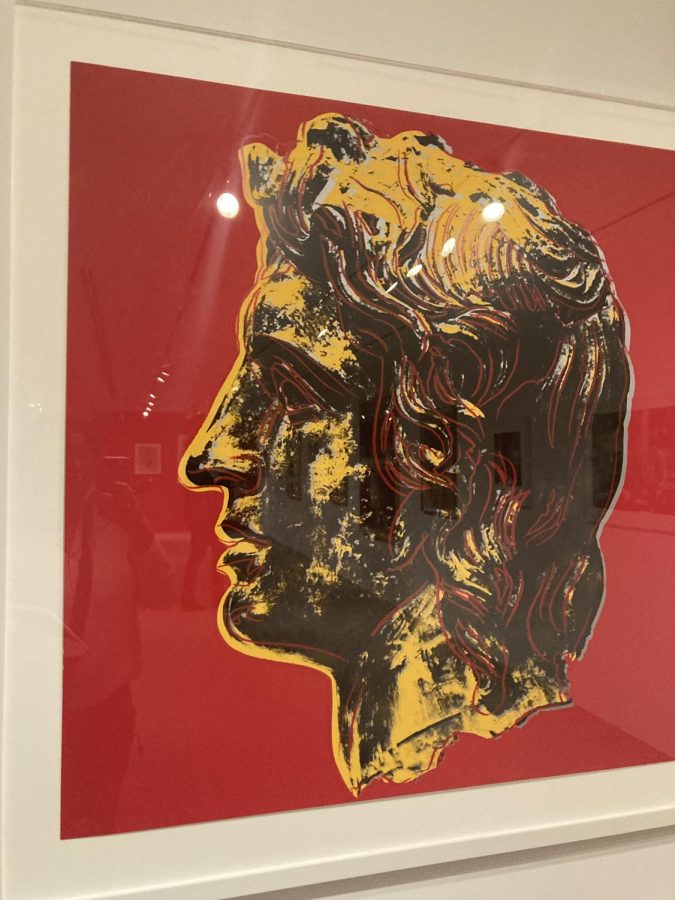Writing on the evolving landscape of gender in the 21st century, art history graduate students and curators Lawrence Gianangeli and Samit Sinha ask, “Is masculinity clearly discernible in art?”
The answer is a resounding “yes” if you look at ancient Greek and Roman art, where idealized male figures were often portrayed in heroic poses representing power and strength. Gianangeli and Sinha’s exhibit, “Masculine Identities: Filling in the Blanks,” presented at The University Museum of Contemporary Art, seeks to uncover the multi-layered answer through the lens of contemporary artwork.
Alexander the Great, the king of the ancient Greek kingdom of Macedonia, embodied the classic perceptions of masculinity in ancient Greek and Roman art. Andy Warhol’s 1982 screen-print “Alexander the Great” reimagines this classic heroic figure of strength and power in his signature pop-art style. Warhol took a photograph of a Roman bust of Alexander the Great and based his portrait on the photograph.
According to Travis Nygard, associate professor of art history at Ripon College, Warhol created a series of silkscreen prints, adding layers of ink to create intricate texture and detail. The contrast of the black and crimson ink jumps at the viewer and the yellow lines outline the face, from his curling hairs to the nape of his neck. The blood-red background highlights the valiant side profile.
The iconic portrait is a contemporary masterpiece, fusing “classic imagery of male beauty with his pop aesthetic of superficiality, fragmentation, and celebration,” according to the exhibitors in a copy of their analytical essay, presented near the artwork. The walls, awash in red, matched the background of the painting and stood in stark contrast to the opposing walls coated in the purest white. Much like the color red, masculinity can take on multiple identities. The exhibitors’ use of red on the gallery walls celebrates the various connotations of the color such as rage, love, excitement and danger.
The brilliant wall color choice is the singular motif of masculinity throughout the exhibition. This is evident in various artworks, like the scarlet carpet in Mika Rottenberg’s untitled photograph, a carnal display of scantily clad figures and restrained men in submissive positions, the burgundy couch featured in John Gintoff’s 1982 “Johnre Photography” of a nude woman and the back of a suited man in an authoritative stance and the carmine background in Dawoud Bey’s 1995 “Chevis II,” a portrait of a pensive young black man.
The exhibition is in the lower right corner of UMCA, within the confines of a small, narrow and elongated space. The art exhibition is best experienced when explored by a few individuals or small groups due to its limited space. The limited space fosters a sense of intimacy between the viewer and the art, encouraging contemplation and reflection. What the room lacks in square footage, it makes up for the sheer width of its four walls. With fewer people there is more room to move around and appreciate the artwork, allowing for a more immersive experience.
The opening reception of the exhibit was on Thursday, March 23. Numerous students, professors and family members of the exhibitors and art lovers filled the space. Several people huddled around Kehinde Wiley’s 2010 “Sharrod Hosten Study III” due to its intriguing nature. In the center of the portrait, the young Black male subject’s face is created in a photorealistic style; the interplay of light and shadow illuminates the warm browns of his skin. In contrast, the background is a vibrant floral patterned background. Wiley replaces historically European subjects with black people, many he encounters on the street, combating the age-old conventions of classical art. The soft and colorful flowery background juxtaposes the stereotypical hyper-masculine and aggressive image black men have long preconceived to have.
Gianangeli and Sinha’s exhibition “Masculine Identities: Filling in the Blanks” offers a contemporary perspective on the multifaceted nature of masculinity. Through a diverse range of artwork, the exhibit showcases how masculinity can take on multiple identities and interpretations.
The use of red throughout the exhibit serves as a unifying motif that highlights the various connotations of masculinity. The exhibition challenges traditional notions of masculinity in art and offers a nuanced understanding of the complexities surrounding gender in the 21st century. The exhibit encourages a deeper reflection on the evolving nature of gender and identity in contemporary art that any modern art enthusiast would enjoy.
Samourra Rene can be reached at [email protected].




















